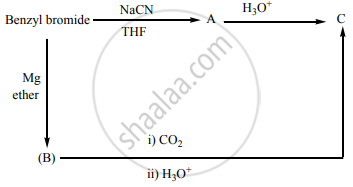Advertisements
Advertisements
Question
Write a reaction to distinguish acetaldehyde from acetone
Solution 1
Tollens’ reagent test: Acetaldehyde being an aldehyde reduces Tollens’ reagent to shining silver mirror, whereas propanone being acetone does not.
\[\ce{\underset{\text{Acetaldehyde}}{CH3CHO} + \underset{\text{Tollens’ reagent}}{2[Ag(NH3)2]+} + 3OH- -> \underset{\text{Acetate ion}}{CH3COO-} + \underset{\text{Silver metal}}{2Ag ↓} + 4NH3 + 2H2O}\]
\[\ce{\underset{\text{Acetone}}{CH3COCH3} ->[Tollens 'reagent] No silver mirror}\]
Solution 2
Fehling’s solution test: Acetaldehyde reduces Fehling’s solution to red precipitate of Cu2O whereas acetone being a ketone does not.
\[\ce{\underset{\text{Acetaldehyde}}{CH3CHO} + \underset{\text{From Fehling’s solution}}{2Cu^2+ + 5OH-} ->\underset{\text{Acetate ion}}{CH3COO-} + \underset{\text{Cuprous oxide (Red ppt.)}}{Cu2O ↓} + 3H2O}\]
APPEARS IN
RELATED QUESTIONS
Answer in brief.
Observe the following equation of reaction of Tollens' reagent with aldehyde. How do we know that a redox reaction has taken place? Explain.
\[\ce{R-CHO + 2Ag(NH_{3})^{+}_{2} + OH^{-}->[\triangle] R-CO{O}^{-} + 2Ag↓ + 4NH3 + 2H2O}\]
Write reaction showing aldol condensation of cyclohexanone.
Explain haloform reaction with suitable example.
Identify A in the following reaction.
\[\ce{A + CH3MgBr ->[Ether] complex ->[H3O+] (CH3)3C - OH}\]
Which of the following gives red precipitate with Fehling's solution?
\[\begin{array}{cc} \phantom{...}\ce{R}\phantom{.................}\ce{R}\phantom{..}\ce{H}\phantom{................}\\ \phantom{...}\backslash\phantom{..................}\backslash/\phantom{..........}\phantom{.......}\\ \ce{C = O ->[H2NNH2][KOH/glycol] C + N2 + H2O}\\ \phantom{}/\phantom{............}\phantom{.......}/\phantom{}\backslash\phantom{...............}\\ \phantom{}\ce{R}\phantom{..................}\ce{R}\phantom{..}\ce{H}\phantom{...............} \end{array}\]
Reaction is called ____________.
In Clemmensen's reaction, ketone gives ____________.
The first oxidation product of secondary alcohols is ____________.
Which of the following is Clemmensen reduction?
Which of the following is a Wolf - Kishner reduction?
Which among the following compounds does NOT undergo aldol condensation?
Identify the product Y in the following series of reactions.
\[\ce{4-Nitrotoluene ->[(CH3CO)2O/CrO3][273 - 278 K] X ->[H3O^+][\Delta] Y}\]
Which one of the following undergoes reaction with 50% sodium hydroxide solution to give the corresponding alcohol and acid.
How is the following conversion effected phenyl methanal into benzoin?
Identify A, B and C.

How will you prepare ethyl acetate from methyl acetate?
How will you prepare benzoic acid from toluene?
How will you prepare malachite green from benzaldehyde?
Primary nitroalkanes are obtained in good yield by oxidising aldoximes with the help of ______.
Which of the following compounds will undergo self-aldol condensation in the presence of cold dilute alkali?
Which of the following is most reactive towards the addition reaction of hydrogen cyanide to form the corresponding cyanohydrin?
Identify the reaction in which carbonyl group of aldehydes and ketones is reduced to methylene group on treatment with zinc-amalgam and cone. HCI.
What is the action of hydrogen cyanide on the following?
Acetone
Write the structure of the products obtained from the following ketones by action of hydrazine in presence of a slightly acidic medium.
Identify B in the following reaction:
\[\begin{array}{cc}
\ce{O}\phantom{........}\\
||\phantom{........}\\
\ce{\underset{(Acetone)}{CH3 - C - CH3}->[CrO3] B}
\end{array}\]
Explain Wolf-Kishner reduction reaction.
Write the structure of the major product of the aldol condensation of benzaldehyde with acetone.
How will you prepare Acetic anhydride from acetic acid.


